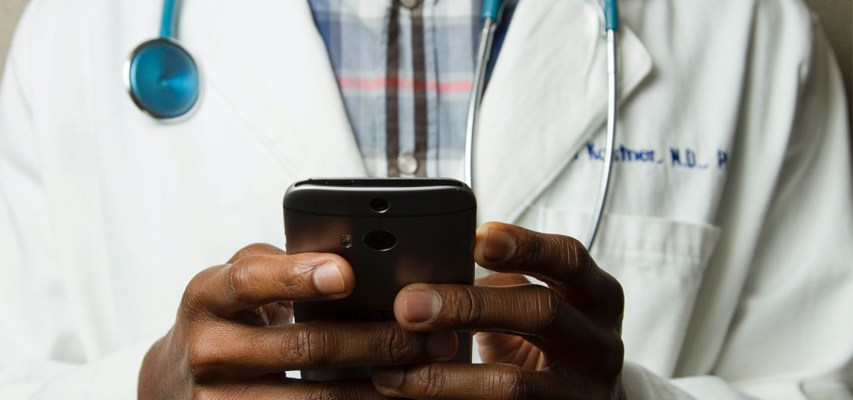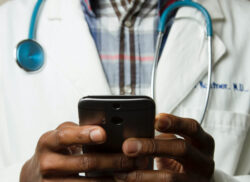
“Indeed, connectivity, in one form or another, has been a necessary component of medical care delivery throughout history. Telemedicine provided the tools for connectivity when providers and recipients of care could not be in the same place and time.” – Bashshur and Shannon, ‘History of Telemedicine.’
Telemedicine is the remote use of telecommunications technology by healthcare practitioners to evaluate, diagnose and treat patients.
The World Health Organisation defines telemedicine as: “The delivery of healthcare services, where distance is a critical factor, by all healthcare professionals using information and communication technologies for the exchange of valid information for diagnosis, treatment and prevention of disease and injuries, research and evaluation, and for the continuing education of healthcare providers, all in the interests of advancing the health of individuals and their communities”.
This phenomenon is becoming increasingly popular, especially in far-flung, marginalised areas, where there are few health centres and health workers.
A good example is Garissa County, where people travel long distances through precarious, hot and dry terrain to seek healthcare. The Kenya Demographic Health Survey (KDHS) of 2014 shows that on average, a woman in Garissa travels 35 kilometres to the nearest health centre. This is a county, out of Kenya’s 47, with the highest rate of maternal deaths. Maternal and infant deaths are good indicators of the health status of any region or country. In Garissa, according to the KDHS, the infant mortality rate is 33 children out of 1,000 live births annually. The national average is 22 out of 1,000 live births per annum.
Kenya’s doctor-to-patient ratio stands at one to 17,000, against the recommended World Health Organisation ratio of one doctor for every 1,000 patients. This means that the situation is worse in places like Garissa. The health workforce report indicates that Garissa had 19 doctors in 2015. When it comes to children-specliased healthcare, you need a paediatrician. Kenya has only 295 paediatricians, with Garissa, a county of one million people, having only two.
But thanks to telemedicine, residents of Garissa, especially in Dadaab, are now reaping the health benefits of technology. This is courtesy of Gertrude’s Children’s Hospital in Nairobi.
An article by Gardy Chacha of The Standard newspaper highlighted how telemedicine works. He narrated the story of four-month-old Abdirahman Abdi who was brought to Dadaab Sub-County Hospital in Garissa writhing in pain. The mother said the child had lost appetite, and that he had not been breastfeeding. He was diagnosed with acute malnutrition. The mother, Yurub Mohamed, was told that the boy needed to see a paediatrician immediately. But since there was no child specialist stationed in Dadaab, Yurub had two daunting options; either travel for three hours through rough terrain to Garissa Level Five Hospital, or take the 400-kilometre journey to Nairobi.
But thankfully, technology came in handy and mother and child did not need to waste precious time on the road. Abdi was examined by Dr Renson Mukhwana of Gertrude’s Children’s Hospital 400 kilometres away in Nairobi through a computer enabled with internet connection.
“Using a set of computers and some accompanying devices, Dr Mukhwana was able to examine Abdi from 414 kilometres away. He was able to read the boy’s vital signs, including his heartbeat, blood pressure and temperature,” wrote Chacha.
The computers on both sides – in Nairobi and Dadaab – are video enabled, with the one in Dadaab zooming on the patient so that the doctor can read vital signs miles away, and even record sounds. The only thing that lacks from the regular doctor check-up is the touch, which in the case of Dadaab, is complemented by the clinical officer stationed there.
“When I am examining a patient, I use sight, hearing and feeling. Images and sound are promptly transmitted. The only thing I cannot do is use my hands to palpate the patient,” said Dr Mukhwana.
With funding from the United Kingdom’s Department for International Development (DFID), through the County Innovations Challenge Fund, the Gertrude’s telemedicine technology mimics the best in the world. It comprises a computer, a video camera and a speaker. To help in diagnosis, another computer is connected to a medical diagnosis and patient monitoring system.
Since its launch in 2017, Gertrude’s says the system has successfully diagnosed and treated over 60 patients.
Similarly, the Aga Khan University Hospital, Mombasa, in August 2018, launched a telemedicine programme. Using digital medical equipment, and connected to high-speed fibre network, the hospital installed digital stethoscopes and multi-purpose scope equipment for examining patients’ vitals to enable diagnosis in real time.
Through this digital technology, the hospital is able to record and store data on the Health Management Information System (HMIS), which is linked to its clinics. Therefore, if a patient travels from Kilifi to Voi, they needn’t go through the pain of being tested afresh. Their records will be available at the click of a button. The hospital’s management says the telemedicine system benefits about 200 patients daily.
But while Gertrude’s Children’s Hospital uses computers for telemedicine, mobile phones are increasingly becoming popular as telemedicine devices. Mobile phone use in Kenya, according to the Communication Authority, is now at 95 percent, with a 50 percent smartphone penetration.
A good example is Safaricom’s M-TIBA, a mobile phone application that allows users to save funds for healthcare. This is groundbreaking in a country where only about a quarter of the population has any form of health insurance, according to data from the Kenya Integrated Household Budget Survey (KIHBS). Subsequently, about 1.5 million Kenyans are pushed below the poverty line because of medical bills, according to research by health experts Thomas Maina and Jane Chuma.
M-TIBA, which has over 4.5 million registered users, ensures the money saved can only be used for healthcare at selected healthcare providers. This affords Kenyans, many of whom pay for their health care out-of-pocket, quality, fair-priced and convenient medical service.
Indeed, the public sector, in the spirit of public-private partnerships, has seen most counties, like Kisumu, embracing M-TIBA to deliver Universal Health Coverage.
The application has received recognition around the globe, noticeably during the 2019 UN High Level Meeting on UHC. During the meeting, World Bank Group President, Mr David Malpass, described M-TIBA as a new model for health financing and delivery.
There are other mobile apps in use by various sector players that, if scaled up, can revolutionise healthcare and accelerate the achievement of Universal Health Coverage. Unfortunately, as the National eHealth Policy notes, most of these technologies are donor-funded, meaning that when the contracts time expire, or the donor funds are depleted, the innovations are rarely scaled up or adopted beyond the pilot phase.
Nonetheless, a number of organisations have continued to introduce ground-breaking technologies, like the Health-E-Net, which specialises in remote consultations. Health-E-Net have a mobile app known as Gabriel Teleconsultations, which is being piloted in Turkana.
Turkana is similar in terrain to Garissa – dry, hot and marginalised – and its residents also travel long distances to seek healthcare. Many die on the way, including mothers in childbirth. The Gabriel Tele-consultations app allows a health worker in any of Turkana’s remote locations to consult a doctor or specialist in the county’s headquarters in Lodwar.
The technology can be used offline and in a 2G environment. This is significant as Turkana doesn’t have a well-developed internet network like other parts of the country close to the capital which use fast 4G fibre connection.
The app records patient data, images, videos and radiology images, which can be reviewed by an expert anywhere on the world. This is very important since, in Kenya, medical records are still entered manually. This means that if a patient in Turkana was to travel to, say Nairobi, they would have to be examined afresh, since the health workers in the city will not have access to the patient’s records.
This is not only time-consuming, but also expensive, in a sector that is already reeling from underfunding and decreasing donor funds. Thus, to achieve Universal Health Coverage, the country needs to invest in digital technology, not only for diagnosing and treating patients remotely, but to also save patients’ data, which can be shared or made available to all providers – private to private, public to public and private to public – whether affiliated to each other or not.
Hospitals like Thika Level 5 have already embraced digital data storage. With partnership from Africa Research Africa, a local NGO, the hospital has a paediatrics and lab information management model for electronic medical records already in use. At the same time, the hospital is working on a similar, but integrated module, for reproductive and sexual health to support antenatal, maternity and gynaecological services.
“In Kenya, mobile penetration continues to rise, according to the Communications Authority,” says Kelvin Waweru of Health-E-Net, “where nine in 10 people have a cellphone. Similarly, Internet use is on the rise, with the majority accessing Internet through mobile. Thus, embracing innovations like mobile telemedicine will help address different aspects of UHC, like availability of human resources, knowledge transfer to nurses in remote areas, and access to specialists. This will reduce unnecessary referrals, improve quality of care, and save Kenyans untold pain and suffering.”
